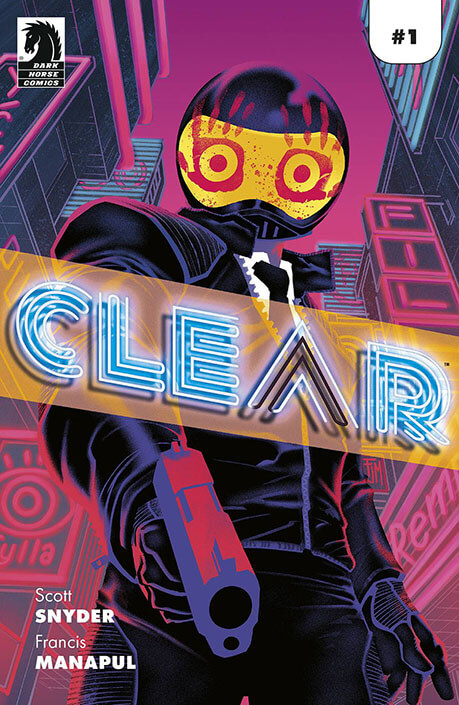“So, here we are. A future that isn’t some primal scream of horror, but a billion little sighs. A fucking shrug.”
When looking through the upcoming Dark Horse releases, several things about this issue caught my eye: the cover, obviously. It’s really striking, a high contrast color palette that jumps off the page, and I love that rough painting on the helmet.
Secondly, Scott Snyder’s name will always make me stop and take a quick look, I’ve certainly liked enough of his work to be hopeful when a new series drops.
But then I saw that Francis Manapul’s the artist and I downloaded the issue and started reading immediately. I’ll never forget seeing his work for the first time on the Flash series and being blown away, I knew this issue would be gorgeous.
And he didn’t disappoint, obviously. The very first page doesn’t have any people, it’s a view from above looking down at a highway, and it’s gorgeous. It’s hard to explain what Manapul does with colors, but the golden lines against the blue background is really stunning. The whole issue was filled with beautiful night scenes lit by neon in the rain.
The first person we see in the book is a woman walking in the rain, and it reminded me how much I love Manapul’s faces, they’re so precise without being over-detailed. His figures are just as precise, great work with anatomy and motion, whether it’s fingers pulling back a hood or a body flying off a motorcycle before spinning into traffic.
As for the plot, it’s the kind of near-future story I really like, where people live lives not much different from ours, except for one major piece of technology that affects everything. In this story that technology is “veils.”
They’d been around for a while, but they really got going in the US after a humiliating wartime defeat. Once called “skins” or “fills” (short for filters) they let the user see the world any way they want, whether it’s 1980s glam or sexy porn world or whatever your heart desires. (Up to a point: “shared” veils are outlawed because if too many people share the same fake reality things get very bad very quickly. It only took a few mass suicides before the laws were updated.)
Our main character is one of the few people who has his settings on “clear,” because he wants to see the world exactly the way it is. It seems to be some kind of self-punishment, because nobody in their right mind wants to see the world the way it is; everything sucks.
“Things cost more. It takes three months to get a washing machine or anything from overseas. There’s news of the world if you want it, but no one does. It’s all just exclamation points.”
(Looking at present day politics, inflation, media, and my parents’ six-month debacle with getting their broken refrigerator replaced, all of that hit a little too close to home.)
This creates a film-noir dystopian feeling for the series: a hard-drinking private investigator with a tragic past, in a grimy world populated by thugs who sell illegal tech to anybody rich enough (or desperate enough) to buy it, while flickers of other people’s dreams show up in mirrors and puddles. I’m in for all of that.
The issue is doing a lot of heavy lifting, exposition wise, which is to be expected in the first book of a series with advanced tech that need to be explained. It was a bit on the wordy side with the internal narrative, (the opening “joke” was a little long) but not annoyingly so, and I’m hoping that, now that we’ve got the broad strokes of the world and the technology, future issues can be heavier on the dialogue and images instead.
But all this is really just the backdrop to the real story, a murder mystery our main character needs to solve. And like any sci-fi mystery it’s going to have to play by the rules set out by the almost magical, future tech, while still making us care about all the individuals, or it’s not going to be satisfying. Going by this first issue, I’m pretty confident it’s going to be satisfying. I’m certainly in for the next issue, because the ending is one heck of a cliffhanger.
